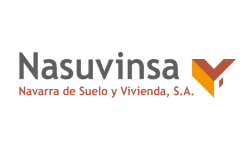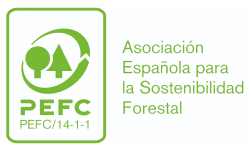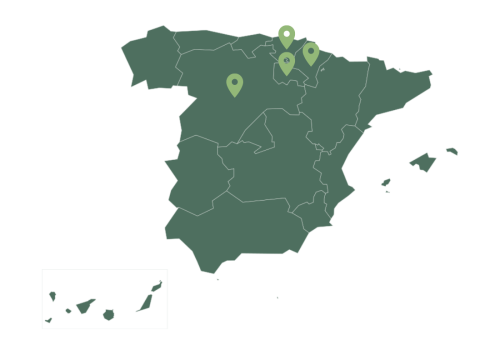The LIFE Haya – Hardwood For The Home project aims to improve the climate change mitigation capacity of beech forests in Spain through a forestry model based on CLOSE TO NATURE FORESTRY. It will focus on climate change adaptation and the promotion of biodiversity in 10 demonstration stands in 4 regions of Spain (Castilla y León, La Rioja, Navarra and Basque Country), generating 250 tonnes of wood used for innovative products and the construction of a sustainable pilot building based on the ‘Hayabitat’ construction system with PEFC, ‘Passivhaus’ and LCA (Life Cycle Assessment) certification under the Level(s) framework.








To improve the knowledge of Fagus sylvatica forests and, in particular, the evolution of their areas, forestry dynamics, conservation status their surface areas, silvicultural dynamics, conservation status, associated biodiversity, risks, vulnerabilities associated biodiversity, risks, vulnerabilities and their capacity as natural carbon sinks, as a technical background for the establishment of the management model close to nature. nature management model.
Test and validate the application of management models with “closer to nature forestry” in demonstration (closer to nature forestry) in demonstrative stands of beech forests that will become the axis be the axis for the development of the fagus labs and a lever for their extension to the rest of the beech forests in the northern third of Spain. of the northern third of Spain.
Articulate a new value chain for the cascading use of beech wood in construction, through the creation of new technological products, under beech wood in construction, through the creation of new technological products, under criteria that criteria that imply a longer carbon storage time in wood products for construction, in particular glued laminated products for construction, specifically glued laminated timber and pinohaya cross-laminated timber.
To integrate and add value to existing knowledge and technology for beech and beechwood in order to facilitate the improvement of their value chain competitiveness. beech wood in order to facilitate the improvement of the competitiveness of its forest-industry value chain. forest-industry value chain.
To construct a demonstration pilot building, which will serve to promote the new wood products developed in the project, as well as to serve as a mechanism to inspire products developed in the project, as well as an inspiration, motivation and learning mechanism for architects and engineers. and learning mechanism for architects and engineers.
To evaluate under different scenarios the global climate change mitigation capacity of beech forests managed under the close-to-nature beech forests managed under the close-to-nature management model, by analyzing carbon fluxes (carbon balances) in through the analysis of carbon fluxes (carbon balances) in forests, products and their application in construction. and its application in construction.
Training and dissemination of the “Hayabitat” system and the PEFC project certification process.

This work package is related to all the specific objectives of the project (SO1-OE6), contributing to good project management that will avoid deviation in the achievement of the expected results, which are:
– Efficient communication and information flow with the European Commission, complying with its requirements.
– Correct follow-up of the project in its planning and monitoring of the project, avoiding deviations in the proposed objectives.
– To promote effective decision-making and communication among members.
– Administrative and financial control of the project.
– Preparation and submission of follow-up reports.
T.1.1 Overall Project Performance
T.1.2 Monitoring of project tasks
T.1.3 Documentary management
T.1.4 Quality control, risk management and contingency plan
This work package is related to all the following specific project objectives
T.2.1 Diagnosis of beech forest carbon sequestration and management characteristics
T.2.2 Vulnerability and risk assessment of beech forests
T.2.3 Committee of Experts and Synthesis
This work package is related to all of the following specific project objectives:
▪ SO2: Test and validate the application of management models with “closer to nature forestry” in demonstrative beech forest stands that will become the axis for the development of the fagus beech forest demonstration stands that will become the axis for the development of the fagus labs and a lever for their extension to the rest of the beech forests in the northern third of Spain. northern third of Spain.
Its development will allow the achievement of the following results:
▪ A model of silviculture transferable to the beech forests of the northern Iberian Peninsula.
▪ 10 demonstration stands where close-to-nature forestry is applied.
▪ A permanent monitoring device for each demonstration stand that will also serve for the transfer and dissemination of silviculture through the use of new technologies.
T.3.1 Close-to-nature silviculture model in beech forests
T.3.2 Prosilva’s network of forestry demonstration stands
T.3.3 Application of monitoring of prosilva demonstration stands
T.3.4 Demonstration stand action plans
T.3.5 Implementation of the close-to-nature management strategy
This work package is related to all of the following specific project objectives:
▪ SO3: Articulate new value chain for the cascading use of beech wood in construction, through the creation of new technological products, under criteria that imply a longer carbon storage time in wood products.
▪ SO4: To integrate and enhance the value of existing knowledge and innovative technology for beech and beechwood in order to facilitate the improvement of competitiveness of the forest-industry value chain.
Its development will allow the achievement of the following results:
▪ Two new engineered wood products developed and certified with CE Marking and Environmental Product Declarations, that while being competitive in the market (quality/price) optimize carbon fixation and storage in their use in buildings.
▪ A new construction system based on the use of beech plywood and pine and beech cross-laminated timber, “Hayabitat,” compatible with cost constraints in the context of public housing.
T.4.1. Development of beech glued laminated timber
T.4.2. Development of combined beech and pine cross laminated timber
T.4.3. Obtaining the CE Marking for both products, necessary to eliminate barriers and reticence in their use.
T.4.4. Obtaining an Environmental Product Declaration (EPD) as a tool for comparison and evidence of the low environmental impact of products. products developed CESEFOR
T.4.5 Development of the “Hayabitat” construction system with high resource efficiency
This work package is related to all of the following specific project objectives:
▪ Articulate a new value chain for the cascading use of beech wood in construction, through the creation of new technological products, under criteria that imply a longer carbon storage time in wood products.
▪ To advance new wood products developed in construction through the development of a pilot building that will serve as a inspirational, motivational and learning mechanism for architects and engineers.
Its development will allow the achievement of the following results:
▪ Implementation of new beech value chain for the development of a pilot building with beech wood structure.
▪ Pilot building based on the “Hayabitat” construction systemcertified PEFC, Passivhaus and with LCA (Life Cycle Assessment) under the framework. Level(s), built with the new engineered beech wood products with wood from demonstration stands.
▪ Methodology for the determination of carbon fluxes based on the management applied in beech forests and the carbon fluxes of beech wood from the new value chain. beech wood from the new value chain.
▪ Strategy for cascading the use of products in beech forests to maximize carbon sequestration time in solid biomass and promote recyclability streams.
T.5.1 Implementation of efficiency processes for the transformation of solid beech biomass in industry
T.5.2. Drafting of pilot building construction project
T.5.3. Production of glulam and cross-laminated timber for the pilot project
T.5.4 Construction of the pilot building: Industrialized production, transport and assembly
T5.5. Environmental certification of the project
T.5.6. Circularity and carbon flow of beechwood products
This work package is related to the following specific project objectives:
▪ SO1: Improve the knowledge of Fagus sylvatica forests and in particular; the evolution of their surface areas, their silvicultural dynamics, conservation status, associated biodiversity, risks, vulnerabilities and their capacity as natural carbon sinks. associated biodiversity, risks, vulnerabilities and their capacity as natural carbon sinks, which will serve as a technical background for the establishment of the management model for the Fagus technical background for the establishment of the management model close to nature.
▪ SO2: Test and validate the application of management models with “closer to nature forestry” in demonstrative beech forest stands that will become the axis for the development of the fagus beech forest demonstration stands that will become the axis for the development of the fagus labs and a lever for their extension to the rest of the beech forests in the northern third of Spain. northern third of Spain.
▪ SO3: Articulate a new value chain for the cascading use of beech wood in construction, through the creation of new technological products, under criteria that imply a longer carbon storage time in wood products for construction, specifically glued laminated timber and specifically glued laminated timber and pine-beech laminated veneer lumber.
▪ SO6: To evaluate under different scenarios the global climate change mitigation capacity of beech forests managed under the model of management with close-to-nature forestry, through the analysis of carbon fluxes in forests, products and their application in construction. construction.
Its development will allow the achievement of the following results:
▪ Establish the basis for generating two business models based on the use of beech wood by two SMEs.
▪ Quantify the increase in CO2 fixation with respect to the baseline, allowing for the generation of a system for generating carbon credits as a as a consequence of improved management.
▪ Quantify the carbon sequestered in carbon products with respect to the baseline, thanks to the development of new products.
▪ Monitoring and control of project indicators (KPIs).
T.6.1 Carbon, biodiversity and climate change adaptation monitoring
T.6.2. Monitoring of the environmental impact of the industrial-construction supply and transformation service.
T.6.3. Monitoring of the socioeconomic impact of project actions and their results
T.6.4. KPI tracking
This work package is related to all the specific objectives of the project.
Its development will allow the achievement of the following results:
– Transferability of the close-to-nature management models to other territories in the northern third of Spain and the South of France through the development of 11 FagusLiving-Labs and the establishment of regional strategies for their future expansion to beech forests in Castilla y León, País de León and País development of 11 FagusLiving-Labs and establishment of regional strategies for their future expansion to the beech forests of Castilla y León, the Basque Country, Navarre and La Rioja (68.7% of the beech forest area in Spain) as a Basque Country, Navarra and La Rioja (68.7% of the beech forest area in Spain) as a mechanism to guarantee its future replicability.
– Transfer of methodologies and technologies developed along the new beechwood value chain as a mechanism to ensure their future replicability. mechanism to ensure their future replicability.
– Two Business Plans for the new engineered beech wood products developed under the project, glued laminated timber from beech and glulam from pine-beech, which will ensure the exploitation of the results obtained in the project after its implementation. and pine-beech cross-laminated timber, which will guarantee the exploitation of the results obtained in the project after its completion. completion of the project.
T.7.1.Co-creation with multiple stakeholders(FagusLiving-Labs)
T.7.2. Expansion of close-to-nature forestry in beech forests
T.7.3. Methodology for carbon credit registry based on improved forest management
T.7.4 Demonstration stand network
T.7.5 Expansion of methodology for the proper manufacture of beechwood products
T.7.6.Entrepreneurship workshops for the opening of new lines of business focused on the manufacture of new beech wood products. Beech
T.7.7. Training and dissemination of theHayabitat system
T.7.8. Training and dissemination of the certification process of construction projects under the PEFC system.
T.7.9. Results exploitation plan
T.7.10. AFTER-LIFE-plan
This work package is transversally related to all the specific objectives of the project, as it promotes the dissemination of the results obtained. results obtained.
It is particularly related to specific objective 1, disseminating to the widest possible European audience the improvement in the knowledge of the forests of Fagus sylvatica forests.
The results expected to be obtained in this work package, through the dissemination of all the objectives proposed in the project are:
– Increase the value and impact of the project.
– Direct specific and planned communication to each target audience.
– To disseminate the results of the project in Europe and to promote and facilitate its replicability and transferability.
– Contribute to the elaboration of a Post-LIFE Plan to ensure the sustainability of the project’s actions and results.
– Promote synergies with other similar projects and initiatives, in order to facilitate the exchange of information, know-how, best practices, etc.
T.8.1 Communication Plan
T.8.2 Project website
T.8.3 Notice Boards
T.8.4 Layman Report
T.8.5 Outreach and awareness-raising campaign targeting the public of interest
T.8.6 Technical congresses
T.8.7. Informative videos
T.8.8. Final event
Suscríbete a nuestra newsletter semestral y recibe en tu bandeja de entrada las últimas noticias o eventos.
¡Únete ahora y forma parte de nuestra comunidad!
Subscribe to our biannual newsletter and receive in your inbox the latest news or events.
Join now and be part of our community!